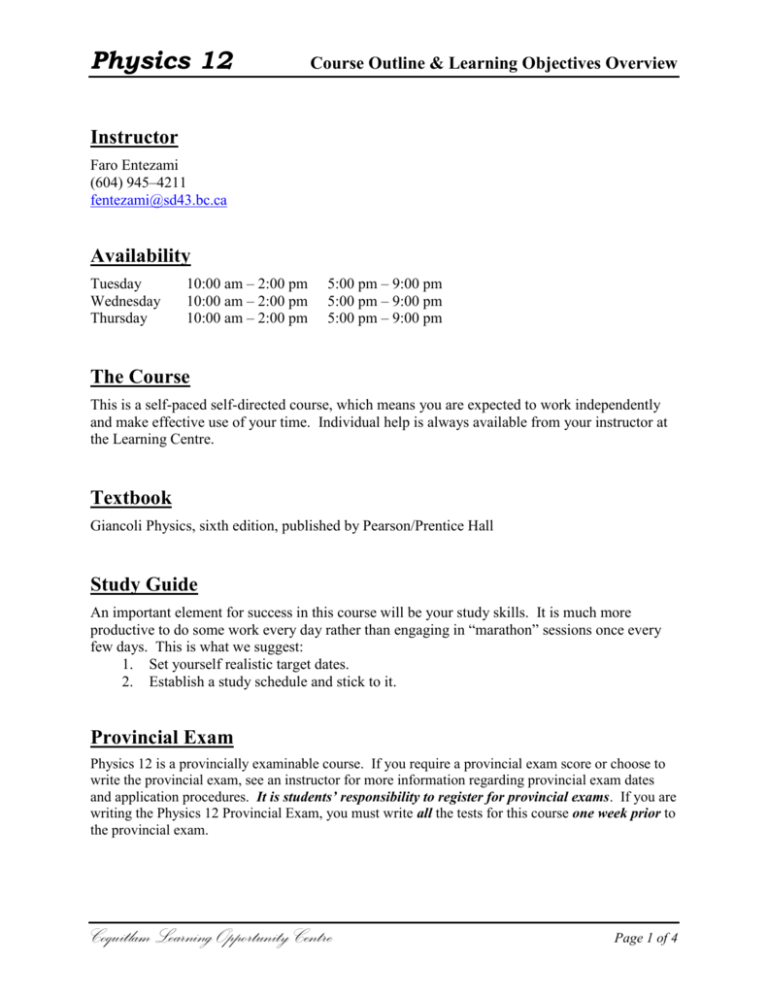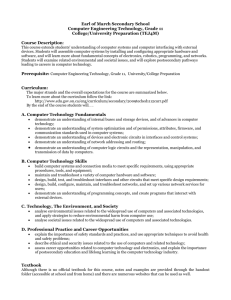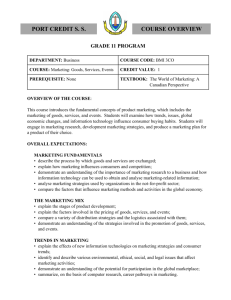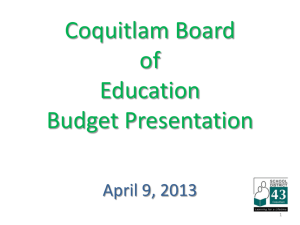
Physics 12
Course Outline & Learning Objectives Overview
Instructor
Faro Entezami
(604) 945–4211
fentezami@sd43.bc.ca
Availability
Tuesday
Wednesday
Thursday
10:00 am – 2:00 pm
10:00 am – 2:00 pm
10:00 am – 2:00 pm
5:00 pm – 9:00 pm
5:00 pm – 9:00 pm
5:00 pm – 9:00 pm
The Course
This is a self-paced self-directed course, which means you are expected to work independently
and make effective use of your time. Individual help is always available from your instructor at
the Learning Centre.
Textbook
Giancoli Physics, sixth edition, published by Pearson/Prentice Hall
Study Guide
An important element for success in this course will be your study skills. It is much more
productive to do some work every day rather than engaging in “marathon” sessions once every
few days. This is what we suggest:
1. Set yourself realistic target dates.
2. Establish a study schedule and stick to it.
Provincial Exam
Physics 12 is a provincially examinable course. If you require a provincial exam score or choose to
write the provincial exam, see an instructor for more information regarding provincial exam dates
and application procedures. It is students’ responsibility to register for provincial exams. If you are
writing the Physics 12 Provincial Exam, you must write all the tests for this course one week prior to
the provincial exam.
Coquitlam Learning Opportunity Centre
Page 1 of 4
Physics 12
Course Outline & Learning Objectives Overview
Course Outline
Module 1: Mechanics
Chapter Omitted Sections
Unit 1
Kinematics in One Dimension
Kinematics in Two Dimensions; Vectors
2
3
Unit 2
Dynamics; Newton’s Laws of Motion
4
Unit 3
Circular Motion; Gravitation
5
4, 5
Unit 4
Work and Energy
Linear Momentum
6
7
2
9, 10
Unit 5
Rotational Motion
Static Equilibrium
8
9
5, 6, 7
Module 2: Electricity and Magnetism
8
Chapter Omitted Sections
Unit 6
Electric Charge and Electric Field
Electric Potential
16
17
10, 11, 12
6, 7, 8, 9, 10, 11
Unit 7
Electric Currents
DC Circuits
18
19
8, 9, 10
5, 6, 7, 8
Unit 8
Magnetism
Electromagnetic Induction
20
21
8, 10, 12
5, 8, 9, 10, 11, 12, 13, 14
You will write a test for each unit and a final exam for each module.
It is important to review chapter 1 in the textbook before starting unit 1.
Assignments
There are three levels of questions in each problem set: I, II, and III. In order to master the skills
included in each section, you are expected to complete as many questions at levels I and II as
necessary. Level III questions and General Problems are optional. Use the answer key at the
end of the textbook to check your work. In addition, you may access a solution manual available
at the following website which contains detailed solutions to all the questions in textbook.
http://ebookbrowse.com/giancoli-physics-6th-solutions-pdf-d191503482
Hard copies of the solution manual are also available at the Learning Centre.
Coquitlam Learning Opportunity Centre
Page 2 of 4
Physics 12
Course Outline & Learning Objectives Overview
Evaluation
All tests will include both multiple-choice and written-response questions.
A standard formula sheet will be provided. You may add any other formulas that you find
useful to this sheet and bring it to all your tests.
The tests will be weighted as follows:
TEST
PERCENT
Unit 1
Unit 2
Unit 3
Unit 4
Unit 5
Module 1 Final
6
6
6
7
8
25
Unit 6
Unit 7
Unit 8
Module 2 Final
7
7
8
20
100
You are expected to write the tests in the above order, starting with the unit 1 test and finishing
with the Module 2 Final.
Important to Remember
All tests must be written at CLOC during the Learning Centre hours on Tuesdays,
Wednesdays, and Thursdays.
You need to write the unit 1 test within 30 days of registering for this course.
There is no rewrite for any of the tests.
You may use a scientific non-programmable calculator on all the tests.
You need to complete all your work and sign out 10 minutes before the closing time.
Prescribed Learning Outcomes
It is expected that students will:
Experiments and Graphical Methods
A1 conduct appropriate experiments
A2 use graphical methods to analyze results of experiments
Vectors
B1 perform vector analysis in one or two dimensions
Coquitlam Learning Opportunity Centre
Page 3 of 4
Physics 12
Course Outline & Learning Objectives Overview
Prescribed Learning Outcomes … continued
It is expected that students will:
Kinematics
C1 apply vector analysis to solve practical navigation problems
C2 apply the concepts of motion to various situations where acceleration is constant
Dynamics
D1 apply Newton’s laws of motion to solve problems involving acceleration, gravitational
field strength, and friction
D2 apply the concepts of dynamics to analyze one- dimensional or two-dimensional
situations
Work, Energy, and Power
E1 analyze the relationships among work, energy, and power
Momentum
F1 use knowledge of momentum and impulse to analyze situations in one dimension
F2 use knowledge of momentum and impulse to analyze situations in two dimensions
Equilibrium
G1 use knowledge of force, torque, and equilibrium to analyze various situations
Circular Motion
H1 use knowledge of uniform circular motion to analyze various situations
Gravitation
I1 analyze the gravitational attraction between masses
Electrostatics
J1 apply Coulomb’s law to analyze electric forces
J2 analyze electric fields and their effects on charged objects
J3 calculate electric potential energy and change in electric potential energy
J4 apply the concept of electric potential to analyze situations involving point charges
J5 apply the principles of electrostatics to a variety of situations
Electric Circuits
K1 apply Ohm’s law and Kirchhoff’s laws to direct current circuits
K2 relate efficiency to electric power, electric potential difference, current, and resistance
Electromagnetism
L1 analyze electromagnetism, with reference to magnetic fields and their effects on moving
charges
L2 analyze the process of electromagnetic induction
Coquitlam Learning Opportunity Centre
Page 4 of 4











